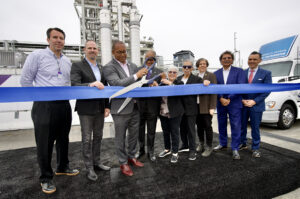Californian Port of Long Beach has released a draft study examining a 70-megawatt battery energy storage system (BESS) proposed by Pier S Energy Storage LLC.
Californian Port of Long Beach has released a draft study examining a 70-megawatt battery energy storage system (BESS) proposed by Pier S Energy Storage LLC.
The BESS would be located on 2.9 acres of the existing, privately owned power generation site at 2665 Pier S Lane.
As explained, the proposed BESS facility would provide additional capacity in response to the California Public Utilities Commission’s mandate to strengthen the reliability of the electric grid as the state transitions to renewable energy resources.
The study being released by the port is called an Initial Study (IS), which concluded that there would be less than significant impacts to the environment with the incorporation of mitigation measures; therefore, a Mitigated Negative Declaration (MND) has been prepared. The public can comment on the draftby January 17, 2025.
Specifically, the proposed project would install up to 200 individual metal containers, each containing lithium-ion battery cells consolidated into racks, a direct current collection system, an alternating current for auxiliary power, a communications network, a fire suppression system, a power conversion system to connect the BESS, and a new 66-kilovolt (kV) substation to transform the voltage between the power conversion system and the substation transmission system. The property has been owned since 2021 by Generation Bridge, a subsidiary of ArcLight Energy Partners Fund.
The existing, 66-kV SCE Long Beach Bus Substation adjacent to the proposed project site to the north would also be upgraded. Additionally, the project proposes to demolish three buildings and sections of abandoned concrete saltwater intake pipes.
In related news, Toyota Motor North America and FuelCell Energy opened several months ago the “first-of-its-kind” Tri-gen system to generate renewable hydrogen, electricity and water to support operations at Toyota’s largest port facility in North America. The Port of Long Beach said that the Tri-gen system uses biogas to produce renewable hydrogen, renewable electricity and usable water, and was built to support the vehicle processing and distribution center for Toyota Logistics Services at Long Beach.
Related Article
-
 Posted: 7 months ago
Posted: 7 months agoHydrogen-based technology to support North American Port of Long Beach
Categories:- Business Developments & Projects
Posted: 7 months ago
A year ago, the port unveiled its intention to advance green hydrogen under the $1.2 billion ARCHES grant. The government has been encouraging the widespread adoption of hydrogen fuel cell-powered equipment across all transportation modes within the port.
Last month, the Long Beach Board of Harbor Commissioners strengthened its commitment to help California reach its renewable energy goals by taking a pair of actions to advance Pier Wind, a proposed 400-acre terminal at the Port of Long Beach to assemble and deploy floating offshore wind turbines.
Taken together, the approvals are aimed at attracting outside funding and authorization to build Pier Wind which would be “the largest facility” of its kind in the United States.
READ MORE
- Long Beach Port: Emission reduction goals achieved ahead of schedule
- Shenzhen, Long Beach to collaborate on decarbonizing ocean trade, new green shipping corridors
- Singapore, LA and Long Beach unveil strategy for green shipping corridor
- Port of Long Beach proposes to build largest offshore wind turbine assembly hub in USA
Content Original Link:
Original Source OFSHORE ENERGY
" target="_blank">



























































